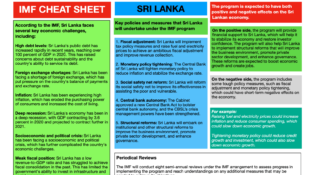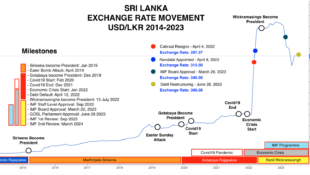Speaking during an interview with Derana TV last Friday (14), he said that Sri Lanka would have to opt for a haircut on domestic debt to achieve debt sustainability, if it wants to avoid tax hikes.
“We will have to go for a local (domestic debt) haircut if we do not increase the taxes,” he said, adding that the Government had to opt for increasing taxes, as going for a haircut in Treasury Bills and Treasury Bonds could pose a huge risk to the banking system.
Last week, the Government gazetted the amendments to the Inland Revenue Act, where the Advance Personal Income Tax (APIT) threshold was decreased to Rs. 1.2 million from Rs. 3 million per annum, while the rates were increased to a maximum of 36%, and corporate income tax in the SME, export, and production sectors was adjusted upto a maximum of 30%.
The total domestic debt stock of Sri Lanka increased to Rs 12.5 trillion at the end of May, from Rs 12.4 trillion in April, while the T-bill and T-bonds amounted to Rs 10.8 trillion.
The staff-level agreement with the IMF states that Sri Lanka should achieve a primary surplus of 2.3% by 2025 from the primary deficit of 4% forecasted for 2022.
Further, Hulangamuwa said that there should be a balance between indirect and direct taxes, as the Government cannot earn sufficient tax revenue only through indirect taxes.
He said the current balance between the indirect and direct taxes is appropriate, as decreasing indirect taxes, which are at 17.5% (with the VAT at 15% and Social Security Contribution Levy at 2.5%), will cause the direct taxes to increase from 36% to at least 50%, which is not something that can be done.
“An increase in direct taxes will impact the development of the economy, as the spending power reduces, leading to a decrease in demand, which will reduce production, while no new investments can be made to businesses with tax rates at 40-50%,” he added.
He said that if Sri Lanka continues on the current path for 1½-2 years, the country can overcome the ongoing crisis.
https://www.themorning.lk/either-haircut-on-local-debt-or-hike-taxes/
Sri Lanka local debt at risk of second hair-cut at CCC: Fitch
story-page-image
ECONOMYNEXT – Sri Lanka’s local currency debt which has taken almost 44 percent hair cut as the rupee collapsed from 200 to 360 to the US dollar may be at risk of a second cut, a rating agency has warned.
A hair cut on rupee debt would also hit bank capital forcing the government to get into more debt to bail them out.
“A default on local-currency debt could erode local banks’ capital positions, possibly leading to government capital injections into the banking sector that would erode the net benefits of such a restructuring, and when we affirmed the Long-Term Local-Currency IDR in May we assumed that the government would continue to service local-currency debt,” the rating agency said.
“Nonetheless, the ‘CCC’ rating reflects a high risk that local-currency debt will be included in debt restructuring, as the stock and interest costs are large, and omitting it could increase the restructuring burden on holders of foreign-currency debt.”
Sri Lanka’s rupee debt holders however have already taken a steep haircut.
Sri Lanka’s rupee has collapsed putting people in marginal income brackets into poverty and sharply lowering living standards and destroying their pensions.
Steep depreciation also raises rupee tax revenues to the government making it easier to service the debt, while keeping rupee spending such as salaries are checked, in an economic phenomenon known as ‘inflating away’ debt.
At the May value of rupee at 360 to the US dollar, the December 21 dollar of rupee debt has fallen to 25.6 billion US dollars from 46.2 billion rupees.
The rupee debt in December 2021 some of which have since been rolled over, is now worth 20.53 billion rupees, amounting to a hair cut of 44 percent.
Most of the debt is owned by banks and pension funds. (Sri Lanka’s EPF hit by US$6.5bn hair cut after soft-peg collapse)
Read full Fitch statement: Sri Lanka faces political risks over Rajapaksa links of new govt
Sri Lanka officials have said only foreign debt would be subject to re-structuring and not rupee debt under terms announced in April 2022 and there was no plans to impose a second hair cut on rupee debt. (Sri Lanka’s stance is to restructure only foreign debt: Governor Weerasinghe)
However some reports by foreign banks in commentaries have raised the possibility that creditors may also demand re-structuring of rupee debt.
Interest on rupee debt has risen to about 31 percent, sharply below the inflation of 50 percent.
Many of the bonds issued or rolled over in 2020 and 2022 were at low rates with large volumes of money printed to keep their yields down contributing to eventual default. (Colombo/July27/2022)
https://economynext.com/sri-lanka-local-debt-at-risk-of-second-hair-cut-at-ccc-fitch-97988/
 would enable you to enjoy an array of other services such as Member Rankings, User Groups, Own Posts & Profile, Exclusive Research, Live Chat Box etc..
would enable you to enjoy an array of other services such as Member Rankings, User Groups, Own Posts & Profile, Exclusive Research, Live Chat Box etc.. 
 Home
Home
















